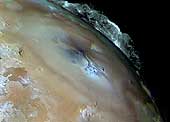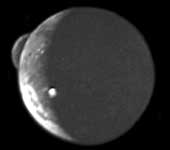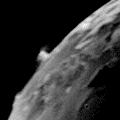
|
Table of Contents |
|
Io's Volcanic Features
|
|
Parent Planet |
|
Io Science |
What powers the tremendous volcanic activity? Tides! But the tides on Io are not like ocean tides we're familiar with on Earth. The gravitational fields of Jupiter and its large moons Europa and Ganymede cause tidal bulges in the solid crust of Io that are as high as 100 meters (330 feet). As Io orbits the giant planet, the bulge moves, flexes the crust, and heats Io's interior like a paper clip bent rapidly back and forth. Infrared observations have shown that the thermal energy released by Io's hot spots is on the order of 125 trillion watts which is about 2.5 W/m2. By contrast the moon's outward heat flow is 0.02 W/m2 and the Earth's average heat flow is 0.06 W/m2.
One week prior to Voyager 1's encounter with Jupiter, Stanton Peale published a paper suggesting that tidal heating might produce volcanism on Io. His prediction was spectacularly confirmed on March 8, 1979 when Voyager 1 captured geyser like eruptions spewing material hundreds of kilometers above Io's surface.
Io Plume Discovery Image: This dramatic view of Jupiter's satellite Io shows two simultaneously occurring volcanic eruptions. One can be seen on the limb, Pele, (at upper left) in which ash clouds are rising more than 150 miles (260 kilometers) above the satellite's surface. The second, Loki, can be seen on the terminator where the volcanic cloud is catching the rays of the rising sun. This is the same image in which Linda A. Morabito, a JPL engineer, discovered the first extraterrestrial volcanic eruption. (Copyright Calvin J. Hamilton) [more] 
Yet mysteries still remain. Why is the lava on Io so hot? Billions of years ago basaltic lava on Earth was about that hot, but now -- thanks to mixing in subduction zones -- terrestrial basalts have a lower melting point. Lavas we see now on Earth are about 300 K cooler than they used to be. It's very surprising to see lava flows on Io as hot as these ancient flows on Earth. Why? Simply because Io's soil has been reworked many, many times, so the melting temperature should be lower for the same reason that Earth's basalts melt at a lower temperature. Originally scientists thought the lava flows were sulfurous, but sulfur vaporizes at ~700 K. The 1800 K regions have to be basaltic. Now the question is, "Are any of the lava flows sulfurous?" The Galileo spacecraft has detected areas on Io with temperatures between 300 and 600 K, which is about right for molten sulfur. In addition, the yellow-brown colors on Io are suggestive of Sulfur compounds.
Volcanic Plumes and Geysers

|
| Volcanic plumes observed by Voyager 2. (© Calvin J. Hamilton) [more] |
So what produces these gigantic plumes? The answer is a phenomenon similar to geysers on Earth. Although geysers are relative small on Earth, the low gravity on Io (about 1/6th that of Earth) and the lack of atmospheric pressure produces the spectacular results observed by the spacecraft explorers. Indeed, if Yellowstone's Old Faithful were placed on Io, its plume would reach heights of 37 kilometers. Yet Io is exceeding dry with little water. So what powers these plumes. Scientists believe that sulfur and sulfur dioxide, which are so abundant on Io, provide the means. When liquid sulfur dioxide comes into contact with hot material below the surface, the superheated, boiling liquid rises quickly through fractures in the surface and produces a high-velocity column of gas. Because of the extremely cold conditions, the gas immediately starts condensing into sulfurous snowflakes. The Galileo spacecraft was fortuitous to fly though the plume of a previously unknown volcano. Its onboard plasma science instrument detected sulfur dioxide snowflakes made of particles that had rushed out of a vent on the ground no more than a few minutes earlier.

The Roll of Sulfur in Io's Volcanoes: Sulfur gas consisting of pairs of sulfur atoms (S2) is ejected from the hot vents of Io's volcanoes (green arrow). The sulfur gas lands on the cold surface, where the sulfur atoms rearrange into molecules of three or four atoms (S3, S4), which give the surface a red color. Eventually the atoms rearrange into their most stable configuration, rings of eight atoms (S8), which form ordinary pale yellow sulfur. [more]

 Io
Io